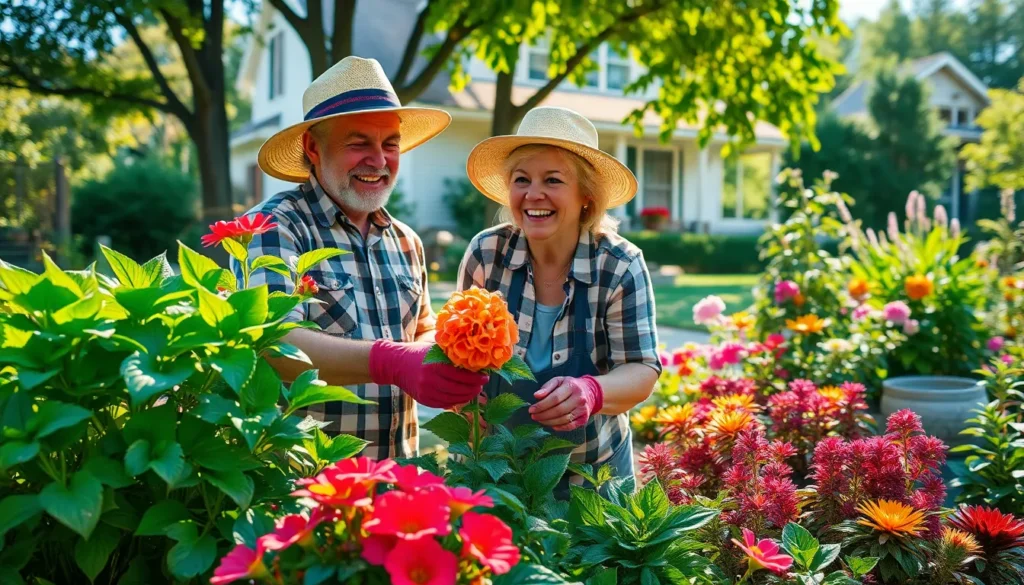We’ve all faced that tricky garden dilemma: finding the perfect plants for spots that get morning shade but blazing afternoon sun. This unique lighting condition creates a challenging microclimate that leaves many gardeners scratching their heads and wondering what’ll actually thrive.
The good news? There’s a surprising variety of stunning plants that not only tolerate but actually prefer this morning shade afternoon sun combination. These resilient beauties have adapted to handle the gentle morning light followed by intense afternoon heat – making them perfect for east-facing gardens, areas behind tall structures, or those spaces where trees block early sun.
Understanding which plants flourish in these conditions can transform your most problematic garden spots into thriving, colorful displays. We’ll show you exactly which varieties to choose and how to create a industry that works with nature’s lighting patterns rather than against them.
Understanding Morning Shade Afternoon Sun Conditions
Garden spaces with morning shade afternoon sun create one of the most challenging yet rewarding microclimates for plant selection. We’ll explore what defines this unique exposure pattern and how it impacts your gardening success.
What Defines Morning Shade Afternoon Sun Exposure
Morning shade afternoon sun exposure occurs when structures, trees, or industry features block early sunlight while allowing intense afternoon rays to reach your garden beds. Buildings positioned to the east of your planting area typically create this pattern by casting shadows during the cooler morning hours. Trees with dense canopies can also filter morning light while allowing harsh western sun to penetrate later in the day.
Geographic orientation plays a crucial role in identifying these conditions in your industry. North facing slopes often experience extended morning shade followed by intense late day sun exposure. Fences, walls, and neighboring structures positioned between your garden and the eastern horizon contribute to this lighting scenario.
We observe this pattern most commonly in urban and suburban settings where buildings create natural barriers to morning sunlight. The condition becomes more pronounced during summer months when the sun’s path shifts and afternoon temperatures peak.
How This Light Pattern Affects Plant Growth
Plants experiencing morning shade afternoon sun face unique physiological challenges that impact their growth patterns and survival rates. Cool morning temperatures combined with limited early light exposure slow photosynthesis during the plant’s most active growing period. Sudden exposure to intense afternoon heat and UV radiation creates stress that many species struggle to manage.
Water loss accelerates dramatically when plants transition from shaded morning conditions to full afternoon sun exposure. Leaves that haven’t gradually acclimated to bright light often develop sunscald or bleaching when subjected to sudden intense radiation. Root systems must work overtime to supply adequate moisture during peak afternoon heat stress.
Temperature fluctuations between cool morning shade and hot afternoon sun can exceed 20 degrees Fahrenheit in a single day. Plants adapted to consistent light conditions often exhibit stunted growth, leaf burn, or complete failure in these variable environments. We find that successful varieties have developed mechanisms to cope with rapid environmental changes.
Measuring Your Garden’s Light Conditions
Accurate light measurement requires tracking sun exposure patterns throughout an entire growing day from sunrise to sunset. We recommend using a simple smartphone app or light meter to record readings every two hours during peak growing season. Document the exact times when direct sunlight reaches different areas of your garden space.
Create a basic chart showing light intensity levels measured in foot candles or lux at exact locations and times. Morning shade areas typically register below 1,000 foot candles before 10 AM, while afternoon sun zones can exceed 8,000 foot candles after 2 PM. These dramatic variations help explain why plant selection becomes so critical for success.
Physical observation provides equally valuable data for understanding your garden’s microclimate patterns. Note which areas remain cool and moist during morning hours versus those that become hot and dry by mid afternoon. Take photographs at different times to visually document shadow patterns and sun penetration throughout the day.
Best Flowering Plants for Morning Shade Afternoon Sun
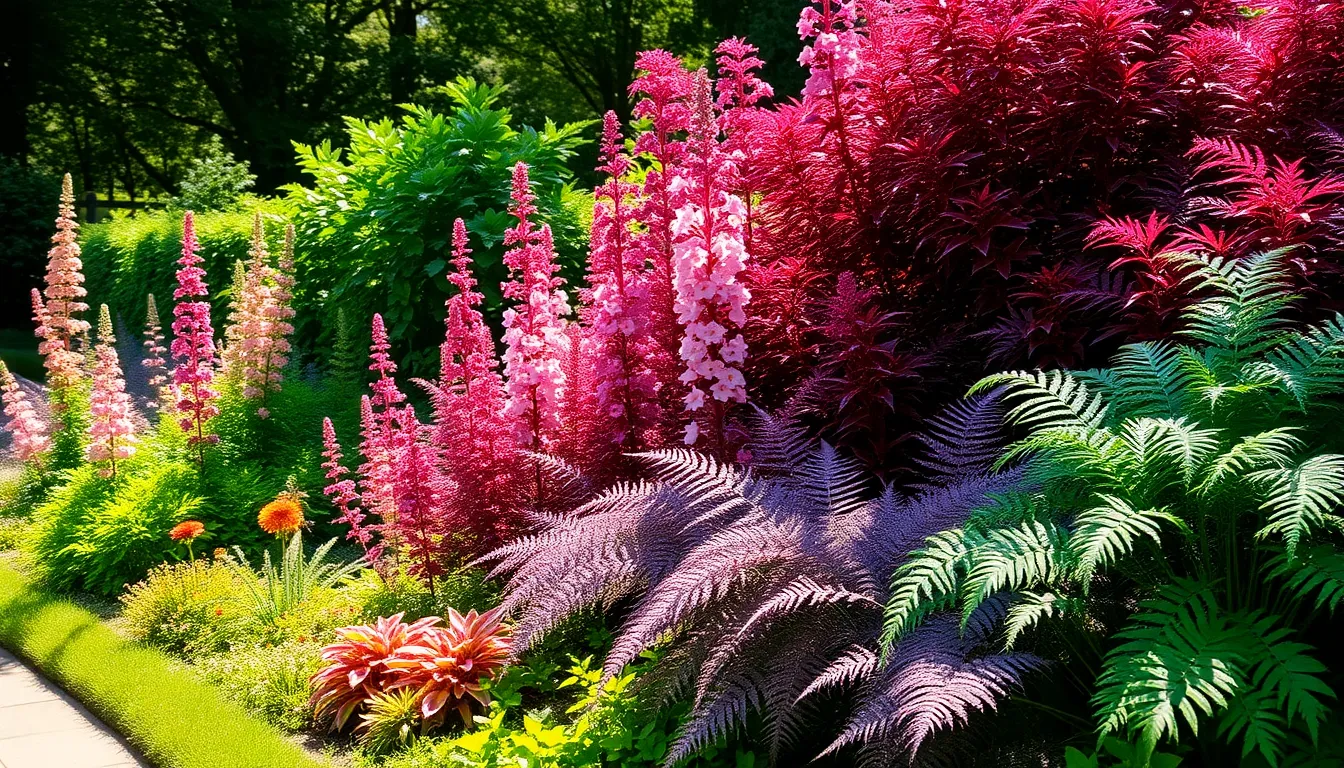
Now that we’ve covered how to assess your garden’s unique lighting conditions, let’s explore the top flowering plants that’ll transform your morning shade afternoon sun spaces into stunning displays.
Astilbe: Feathery Blooms That Thrive in Partial Shade
Astilbe creates dramatic focal points with its distinctive feathery, plume-like flowers that dance above elegant foliage throughout the growing season. These perennials produce blooms in gorgeous shades of white, pink, and red, offering us versatile color options for any garden palette. We particularly love how astilbe performs exceptionally well in morning shade with afternoon sun exposure, making it perfect for our challenging lighting conditions.
Growing astilbe successfully requires moist, well-drained soil that retains consistent moisture without becoming waterlogged. The plants reach heights of 1-4 feet depending on the variety, creating stunning vertical interest in garden beds. Their graceful texture adds softness to shaded areas while the afternoon sun helps promote robust flowering without causing stress to the foliage.
Heuchera: Colorful Foliage Plants for Dappled Light
Heuchera brings year-round visual interest through its vibrant, colorful foliage that ranges from deep purple and burgundy to bright lime green and coral tones. We find these coral bells particularly valuable because they tolerate morning shade beautifully while benefiting from afternoon sun exposure to maintain their intense leaf color vibrancy.
These compact perennials form neat mounds of ruffled leaves that create perfect edging along pathways or fill in gaps between larger plants. Heuchera thrives in dappled or partial shade environments, making it an ideal choice for spaces that receive filtered morning light followed by direct afternoon sun. The plants produce delicate flower spikes in late spring or early summer, adding another layer of beauty to their already stunning foliage display.
Japanese Painted Fern: Elegant Silvery Leaves
Japanese Painted Fern stands out as one of the most sophisticated foliage plants we can grow in morning shade afternoon sun conditions. These ferns feature elegant silvery leaves with striking hints of purple and green that create a luminous effect in darker garden corners. We appreciate how this plant adds textural contrast and brightens shaded areas without requiring direct morning sunlight.
Perfect for adding foliage interest to challenging spots, Japanese Painted Fern thrives in partial shade environments while tolerating the transition to afternoon sun exposure. The plants prefer moist, humus-rich soil that mimics their natural woodland habitat. Their delicate, arching fronds create a soft, romantic appearance that complements both flowering plants and other shade perennials beautifully.
Top Vegetable Crops for Morning Shade Afternoon Sun Gardens
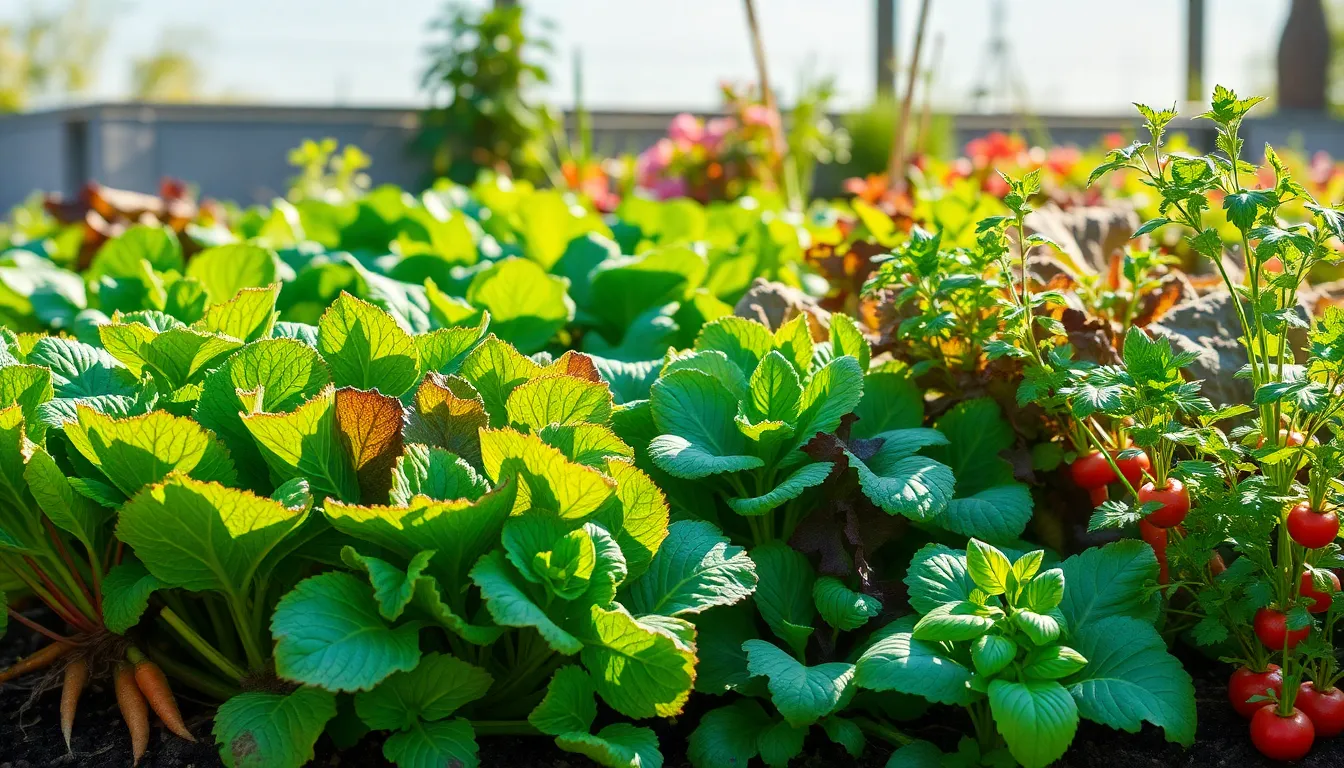
Growing vegetables in morning shade afternoon sun conditions requires selecting crops that can handle cooler mornings followed by intense afternoon heat. We’ve identified three main categories of vegetables that excel in these unique light patterns.
Leafy Greens That Prefer Cool Morning Shade
Leafy greens thrive in morning shade afternoon sun gardens because they’re naturally sensitive to heat and intense sunlight. Spinach performs exceptionally well in these conditions since it avoids the stress of harsh morning sun while still receiving enough afternoon light for photosynthesis. Lettuce varieties including romaine, butterhead, and leaf lettuce benefit from the cooler morning temperatures that prevent early wilting and bolting.
Kale emerges as another excellent choice for this light pattern, as it can handle afternoon sun without losing its crisp texture or developing bitter flavors. Arugula grows vigorously in morning shade conditions and maintains its signature peppery taste when protected from excessive heat during vulnerable morning hours. Swiss chard displays its colorful stems beautifully while avoiding the leaf scorch that often occurs with too much morning sun exposure.
Mustard greens complete our leafy green recommendations by tolerating the afternoon heat while benefiting from gentle morning shade that prevents premature flowering. Morning sun helps dry dew and reduce disease risk on these moisture loving plants, making this light pattern ideal for healthy leaf development.
Root Vegetables That Tolerate Partial Sun
Root vegetables demonstrate remarkable adaptability to morning shade afternoon sun conditions since their edible portions develop underground. Carrots flourish in these gardens because they need sufficient light for top growth while their roots remain protected from temperature fluctuations. Beetroot produces both edible roots and nutritious greens that handle the transition from cool shade to warm sun effectively.
Radishes grow quickly in partial sun conditions and actually prefer some protection from intense morning heat that can cause them to become woody or overly spicy. Parsnips develop their sweet flavor when given afternoon sun for energy production while morning shade prevents the stress that can lead to tough, fibrous roots. Potatoes benefit from morning shade that keeps their shallow root systems cool while afternoon sun provides the energy needed for tuber development.
Turnips round out our root vegetable selection by producing both roots and greens that tolerate mixed light conditions without compromising flavor or texture. These crops generally require some afternoon sun for proper energy production but avoid the stress of prolonged intense heat exposure.
Herbs That Flourish in Mixed Light Conditions
Herbs adapt remarkably well to morning shade afternoon sun gardens, though different varieties have exact preferences within this light pattern. Cilantro performs best with morning shade protection since it’s prone to bolting in hot conditions, while the afternoon sun provides enough energy for robust leaf production. Parsley thrives in these mixed light conditions because it avoids the wilting that occurs with too much morning sun while still receiving adequate light for growth.
Mediterranean herbs show surprising versatility in morning shade afternoon sun gardens, contrary to their reputation for needing full sun. Basil varieties including sweet basil and Thai basil handle morning shade well when followed by afternoon warmth that enhances their essential oil production. Oregano and thyme can tolerate partial shade conditions while still developing the concentrated flavors that make them valuable in cooking.
Chives grow continuously in morning shade afternoon sun conditions and produce their mild onion flavored leaves without the stress that full sun can create. Many warm weather herbs actually benefit from some protection during the hottest part of the day, making morning shade afternoon sun gardens ideal for maintaining herb quality while ensuring adequate light for photosynthesis.
Stunning Shrubs and Trees for Morning Shade Afternoon Sun Areas
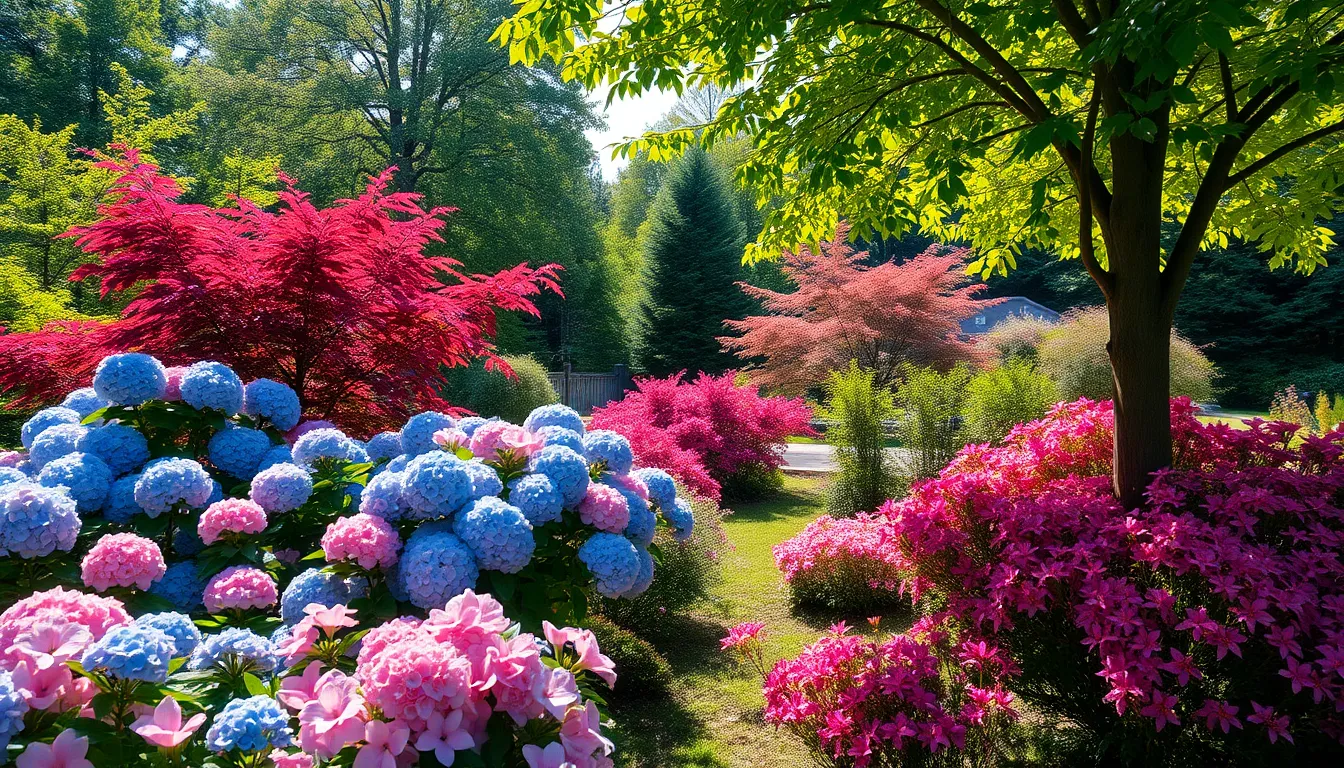
We’ve found that larger plants create the backbone of successful gardens in these transitional light zones. Shrubs and trees provide structure while adapting beautifully to the unique challenges of morning shade followed by intense afternoon sun.
Hydrangeas: Perfect Partial Shade Bloomers
Hydrangeas thrive in spots that receive filtered or partial sunlight throughout the day. We recommend planting these stunning bloomers in areas where they’ll get protection from harsh afternoon sun, which prevents wilting and damaging leaf scorch. Their large flower clusters burst into bloom during spring and summer, offering gardeners spectacular displays in shades of blue, pink, white, and purple.
Protection from morning chill followed by gentle afternoon warmth creates ideal growing conditions for hydrangeas. We’ve observed these shrubs perform exceptionally well when they receive some shelter during the hottest part of the day. The combination helps preserve their impressive blooms and keeps foliage looking healthy throughout the growing season.
Japanese Maple: Gorgeous Foliage Trees for Filtered Light
Japanese maples adapt exceptionally well to locations with morning shade and afternoon sun exposure. We prize these elegant trees for their delicate, colorful foliage that ranges from deep red to bright green depending on the variety. Their preference for filtered light makes them perfect candidates for gardens with transitional lighting patterns.
Filtered sunlight helps preserve the intense leaf color that makes Japanese maples so desirable. We’ve found that protection from direct morning sun followed by dappled afternoon light prevents sun damage while maintaining the vibrant hues. These trees add sophistication and visual interest to any garden space, creating stunning focal points in areas where other plants might struggle.
Azaleas and Rhododendrons: Spring Flowering Favorites
Azaleas and rhododendrons flourish in areas that combine morning shade with afternoon sun exposure. We love these acidic soil loving shrubs for their prolific spring blooms that create breathtaking displays in pink, white, red, and purple. Both plants benefit from some protection during the hottest afternoon hours to maintain optimal leaf health.
Spring flowering season brings out the best in these remarkable shrubs when they’re positioned correctly. We recommend ensuring they receive morning protection followed by filtered afternoon light to extend flower longevity. The combination of cool morning temperatures and gentle afternoon warmth creates perfect conditions for their spectacular seasonal show.
Ground Cover Plants That Excel in Morning Shade Afternoon Sun
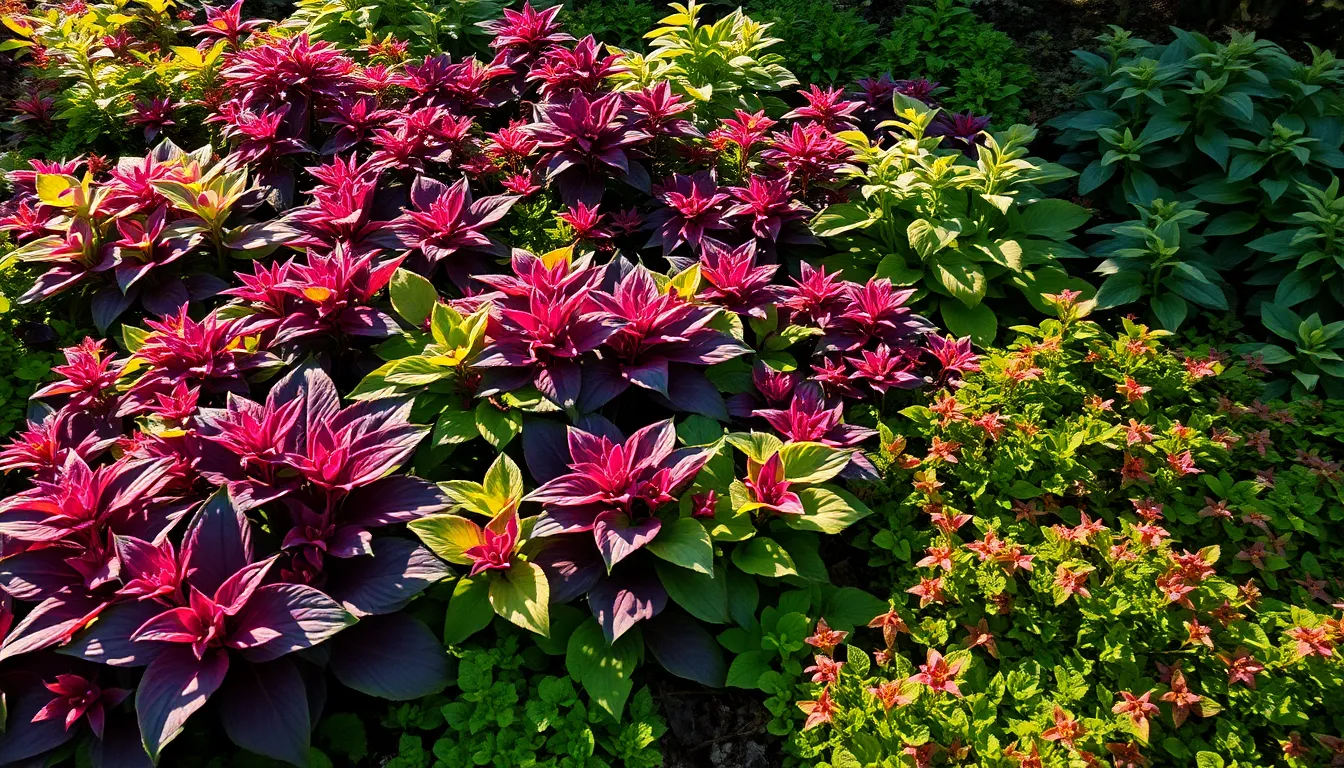
Ground cover plants provide the foundation for gardens transitioning between morning shade and afternoon sun. These low-growing options create cohesive landscapes while handling the unique challenges of mixed lighting conditions.
Hostas: Classic Shade Perennials with Afternoon Sun Tolerance
Hostas deliver lush foliage displays that thrive in morning shade environments while tolerating afternoon sun exposure in cooler climates. These versatile perennials offer diverse leaf textures ranging from smooth to heavily ribbed surfaces, with color variations spanning deep greens to creamy variegations. We recommend selecting varieties specifically bred for sun tolerance to prevent leaf scorch during intense afternoon heat periods.
Moisture retention becomes crucial for hosta success in mixed light conditions. These plants prefer well-drained soil that maintains consistent moisture levels throughout the day. Dappled sunlight conditions work exceptionally well for most hosta varieties, allowing them to receive gentle morning protection while benefiting from filtered afternoon light.
Coral Bells: Low-Growing Options for Partial Shade
Coral Bells showcase vibrant foliage colors that intensify with proper light exposure in morning shade afternoon sun locations. Their compact growth habit makes them ideal ground cover choices, with mature heights typically reaching 8 to 12 inches. Foliage colors range from deep purples and burgundies to bright lime greens and peachy oranges, creating stunning visual interest throughout the growing season.
Afternoon sunlight exposure helps maintain the vibrant leaf coloration that makes Coral Bells so desirable. These hardy perennials produce delicate flower spikes that rise above the foliage in late spring and early summer. We find they perform best when planted in groups of three to five plants, creating natural drifts that enhance their ground cover effectiveness.
Ajuga: Spreading Ground Cover for Mixed Light
Ajuga establishes robust ground cover that spreads efficiently to fill large areas in morning shade afternoon sun gardens. This evergreen perennial offers several cultivar options, including ‘Chocolate Chip’ with its compact dark foliage and ‘Catlins Giant’ featuring larger leaves and more vigorous spreading habits. Spring blooms produce attractive blue flower spikes that add vertical interest to the low-growing carpet of leaves.
Moisture loving characteristics make Ajuga particularly well suited for areas that receive morning dew protection followed by afternoon sun exposure. The plant’s spreading nature helps suppress weeds naturally while providing year-round visual interest through its persistent foliage. We observe that Ajuga tolerates foot traffic better than many other ground covers, making it practical for pathways and border edges in mixed light conditions.
Native Plants Adapted to Morning Shade Afternoon Sun Environments
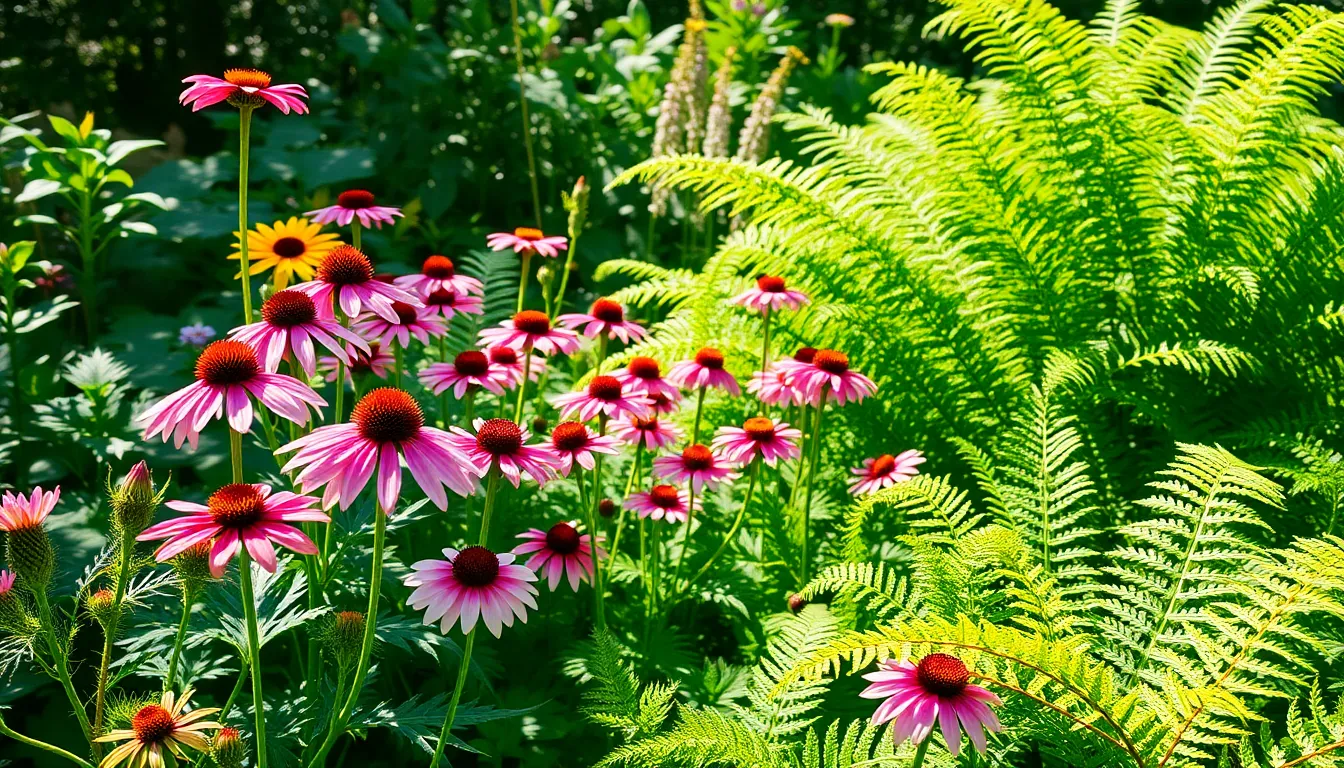
Native plants offer the perfect solution for gardens with morning shade and afternoon sun because they’ve naturally evolved to handle local growing conditions. These indigenous species typically outperform non-native alternatives in challenging microclimates while supporting local wildlife ecosystems.
Regional Native Species for Partial Shade Gardens
Coneflower (Echinacea spp.) stands out as one of North America’s most reliable native perennials for morning shade afternoon sun conditions. Growing 2 to 3 feet tall, this powerhouse blooms continuously from summer through fall while serving as essential wildlife food for birds and pollinators. We’ve found that coneflowers actually benefit from the morning shade protection, which prevents early morning dew from causing fungal issues on their blooms.
Canada Anemone (Anemone canadensis) thrives specifically in partial shade environments that receive afternoon sun exposure. Reaching about 12 inches tall, this charming native produces delicate white flowers during its May through June blooming period. Forest edge natives like Canada Anemone prove more resilient than deep woodland species because they’re naturally adapted to alternating light conditions.
Daylilies demonstrate exceptional tolerance for morning shade afternoon sun patterns while delivering spectacular, long-lasting blooms throughout the growing season. These robust perennials establish quickly and multiply over time, creating stunning displays that improve year after year. Butterfly bush and Sedum varieties also show remarkable adaptability to these challenging light conditions, with both species thriving rather than merely surviving.
Wildflowers That Thrive in Dappled Sunlight
Spring ephemerals represent nature’s perfect solution for morning shade afternoon sun environments because they complete their entire blooming cycle before trees fully leaf out. Bloodroot emerges early with pristine white flowers that capture available spring light before canopy shade increases. Trilliums follow with their distinctive three-petaled blooms, utilizing the same strategy of early emergence and rapid flowering.
Virginia bluebells carpet woodland floors with cascades of pink buds that open to sky blue flowers, timing their display perfectly with available light patterns. These remarkable wildflowers go completely dormant after their brief but spectacular spring show, leaving space for other plants to fill the growing season. We recommend planting spring ephemerals in clusters to create natural-looking drifts that mimic their wild growing patterns.
Native Ferns for Shaded Morning Areas
Christmas fern (Polystichum acrostichoides) provides year-round structure in morning shade areas while tolerating moderate afternoon sun exposure. This evergreen native maintains its glossy green fronds through winter, offering consistent visual interest when other plants go dormant. Christmas ferns prefer well-drained soils and establish slowly but surely, eventually forming substantial clumps.
Lady fern (Athyrium filix-femina) creates delicate, lacy textures that soften harsh afternoon light while thriving in morning shade conditions. Growing in graceful arching clumps, lady ferns appreciate consistent moisture and protection from the most intense afternoon rays. These deciduous natives emerge fresh each spring with bright green fronds that gradually mature to deeper forest green.
Both fern species excel in transitional light zones where morning shade gives way to filtered afternoon sun, creating the perfect foundation plantings for layered native gardens. We’ve observed that these native ferns actually perform better than exotic species in challenging microclimates because they’re genetically programmed to handle local weather extremes.
Essential Care Tips for Morning Shade Afternoon Sun Plants
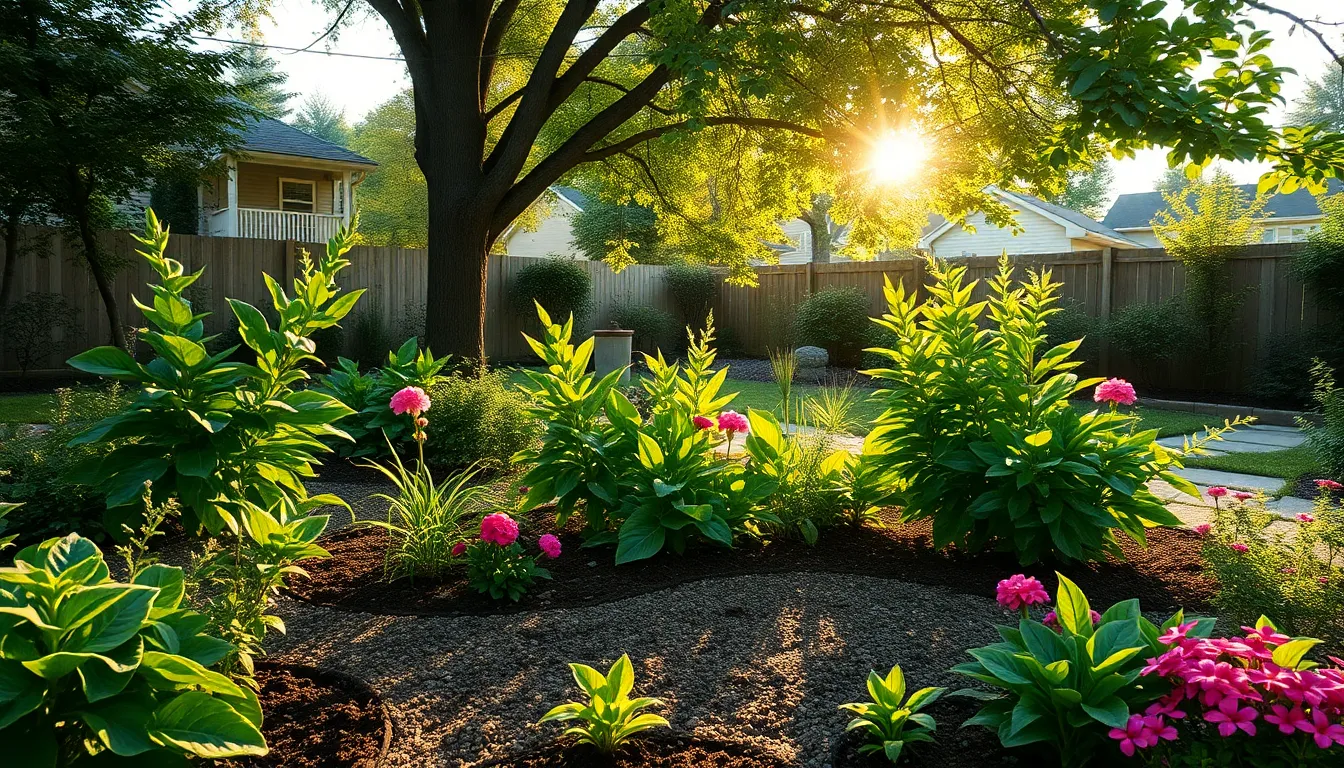
Successfully growing plants in morning shade afternoon sun conditions requires understanding their unique needs as they transition between cooler, shaded mornings and warmer, sunnier afternoons. We’ll focus on three critical care aspects that ensure your plants thrive in these challenging light patterns.
Watering Strategies for Partial Shade Gardens
Early morning watering provides the most effective approach for plants experiencing afternoon sun exposure. We recommend watering between 6-8 AM to minimize evaporation and allow foliage to dry completely before heat increases transpiration rates.
Deep watering techniques help plants absorb moisture before afternoon temperatures rise. Water slowly at the soil level rather than overhead to prevent fungal diseases that commonly affect plants in variable light conditions. Avoid overhead sprinklers that wet leaves during the transition to afternoon sun.
Drip irrigation systems offer targeted moisture delivery without waste, particularly beneficial in drier climates where afternoon sun rapidly depletes soil moisture. Monitor soil moisture levels regularly using your finger or a moisture meter, checking 2-3 inches below the surface. Adjust watering frequency based on soil drainage and competing root systems from nearby trees or shrubs.
Soil Requirements and Amendments
Well-draining soil with organic matter creates the foundation for healthy morning shade afternoon sun plants. We enhance soil structure by incorporating 2-3 inches of compost or well-rotted leaf mulch annually. Rich, fertile soil helps plants withstand the stress of transitioning between shade and sun conditions.
Organic amendments improve water retention while maintaining proper drainage. Add compost, aged manure, or leaf mold to increase the soil’s moisture-holding capacity without creating waterlogged conditions. Test soil pH annually, aiming for slightly acidic to neutral levels (6.0-7.0) that support most partial shade plants.
Mulching around plants conserves moisture and moderates soil temperature fluctuations. Apply 2-4 inches of organic mulch like shredded bark or leaves, keeping mulch 2-3 inches away from plant stems. Replace mulch seasonally as it decomposes and enriches the soil naturally.
Seasonal Maintenance and Pruning
Regular pruning improves air circulation and light penetration, essential for plants adapting to variable light conditions. Remove dead, damaged, or overcrowded growth during late winter or early spring before new growth begins. Deadhead spent flowers throughout the growing season to encourage continued blooming and maintain plant vigor.
Spring maintenance includes refreshing mulch layers and checking for winter damage or pest issues. We inspect plants for signs of fungal problems that may develop in the transition zones between shade and sun. Remove any diseased foliage immediately to prevent spread to healthy plant parts.
Fall preparation involves cutting back perennials after the first frost and applying fresh mulch for winter protection. Clean up fallen leaves and debris that harbor pests or diseases over winter. Monitor established plants for signs of stress and adjust care routines based on their performance in your exact microclimate conditions.
Common Mistakes to Avoid When Growing Morning Shade Afternoon Sun Plants
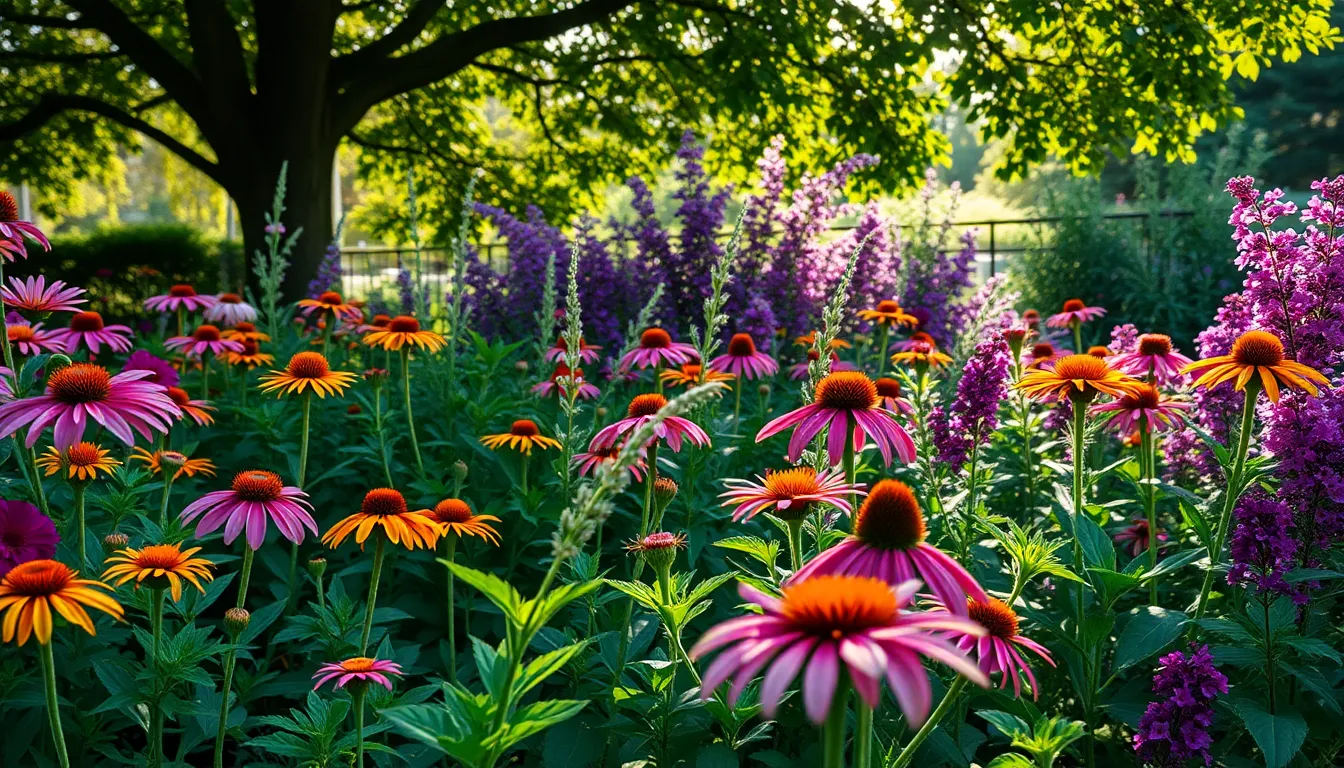
Understanding the pitfalls that derail morning shade afternoon sun gardens helps us achieve the thriving industry we envision. We’ve identified three critical mistakes that consistently sabotage gardening success in these unique microclimates.
Overwatering in Shade Conditions
Morning shade areas retain moisture far longer than we typically anticipate due to reduced evaporation rates. Soil in these shaded zones stays moist throughout the day, making our plants vulnerable to root rot and fungal diseases when we follow standard watering schedules. We must check actual soil moisture levels rather than watering on autopilot, since the combination of shade and retained moisture creates perfect conditions for devastating plant diseases.
Adjusting our watering frequency based on real soil conditions prevents the waterlogged disaster that kills more morning shade afternoon sun plants than drought ever could. Plants suffering from overwatering in shade conditions often display yellowing leaves, musty soil odors, and stunted growth that gardeners mistakenly attribute to insufficient sunlight.
Choosing Plants with Wrong Light Requirements
Selecting full shade or full sun exclusive plants for morning shade afternoon sun locations sets us up for disappointment and plant stress. We need varieties specifically adapted to this transitional light pattern, such as coneflowers, phlox, butterfly bushes, and Canada anemones that handle the dramatic shift from cool shade to intense heat. Plants requiring consistent lighting conditions struggle with the temperature and intensity fluctuations inherent in morning shade afternoon sun environments.
Full shade plants often wilt and burn when afternoon sun hits, while full sun varieties may develop weak, spindly growth during their morning shade period. We achieve better results by researching each plant’s exact tolerance for mixed lighting rather than assuming adaptability.
Ignoring Seasonal Light Changes
Seasonal variations dramatically alter the light patterns in our morning shade afternoon sun gardens as tree canopies change and sun angles shift throughout the year. Plants receiving perfect light balance in spring may face excessive afternoon heat exposure in summer or insufficient light in winter when deciduous trees drop their leaves. We must monitor our garden’s changing conditions and adjust plant placement accordingly to prevent seasonal stress.
Summer’s intense afternoon sun can scorch plants that thrived in gentler spring conditions, while winter’s increased light penetration through bare branches may benefit some species but overwhelm others. Tracking these seasonal shifts allows us to relocate sensitive plants or provide temporary shade structures during peak summer heat.
Conclusion
We’ve explored the exciting possibilities that morning shade afternoon sun gardens offer. These unique microclimates don’t have to limit our gardening dreams—they can actually enhance them when we choose the right plants and techniques.
Success in these transitional light zones comes down to understanding our exact conditions and selecting plants that thrive in mixed lighting. From stunning astilbe and colorful heuchera to productive leafy greens and majestic Japanese maples we have countless options to create beautiful functional gardens.
Remember that proper watering timing mulching and soil preparation are just as important as plant selection. By avoiding common mistakes like overwatering and choosing incompatible plants we’ll set ourselves up for gardening success.
Your morning shade afternoon sun garden can become a showcase of diverse textures colors and seasonal interest. With the right approach these challenging spaces transform into some of the most rewarding areas in our landscapes.
Frequently Asked Questions
What is morning shade afternoon sun exposure?
Morning shade afternoon sun occurs when structures or trees block early sunlight while allowing intense afternoon rays to reach garden beds. This common pattern creates a unique microclimate where plants experience cool, shaded conditions in the morning followed by direct, intense sunlight in the afternoon. It’s frequently found in urban and suburban settings.
How does morning shade afternoon sun affect plant growth?
This light pattern creates physiological challenges for plants by combining cool morning temperatures with sudden exposure to intense afternoon heat. Plants can experience stress from the dramatic temperature and light changes, potentially leading to stunted growth, leaf burn, and difficulty adapting to the contrasting conditions throughout the day.
What flowering plants thrive in morning shade afternoon sun?
Astilbe, with its feathery blooms, performs excellently in these conditions. Heuchera offers vibrant foliage colors and adapts well to mixed lighting. Japanese Painted Fern provides elegant silvery leaves that brighten shaded areas. These plants are specifically adapted to handle the transition from shade to sun exposure.
Can I grow vegetables in morning shade afternoon sun areas?
Yes, several vegetables thrive in these conditions. Leafy greens like spinach and kale adapt well to mixed lighting. Root vegetables such as carrots and potatoes can handle the light variations. Herbs like cilantro and basil also perform well, making it possible to maintain a productive vegetable garden.
Which shrubs and trees work best in these conditions?
Hydrangeas are excellent choices, offering beautiful blooms and good sun tolerance. Japanese maples provide stunning foliage and adapt to light transitions. Azaleas and rhododendrons create spectacular displays while handling mixed lighting conditions. These larger plants help create structure in transitional light zones.
What ground cover plants excel in morning shade afternoon sun?
Hostas are ideal with their lush foliage and afternoon sun tolerance. Coral Bells provide vibrant colors and adapt well to light changes. Ajuga spreads efficiently and tolerates foot traffic while handling mixed lighting conditions. These options create cohesive landscape foundations in challenging areas.
Why should I consider native plants for these conditions?
Native plants are naturally adapted to local microclimates and perform better in morning shade afternoon sun conditions. They support local wildlife ecosystems while requiring less maintenance. Species like Coneflower, Canada Anemone, and Daylilies thrive in these light patterns while providing beauty and environmental benefits.
How should I water plants in morning shade afternoon sun areas?
Water early in the morning to help plants absorb moisture before afternoon heat stress. Use deep watering techniques to encourage strong root development. Apply water slowly and thoroughly rather than frequent shallow watering. This approach helps plants better cope with the intense afternoon sun exposure.
What soil conditions work best for these microclimates?
Well-draining soil enriched with organic matter is essential. The soil should retain moisture for morning shade needs while draining excess water to prevent root rot. Adding compost improves soil structure and water retention. Proper drainage becomes crucial during intense afternoon sun periods to prevent plant stress.
What common mistakes should I avoid in morning shade afternoon sun gardens?
Avoid overwatering in shaded areas, which can cause root rot and fungal diseases. Don’t choose plants designed for full shade or full sun, as they may struggle in transitional conditions. Always monitor seasonal light changes throughout the year, as sun patterns shift and affect plant placement and health.

